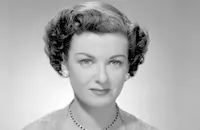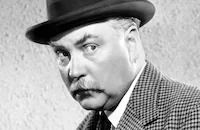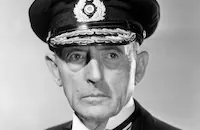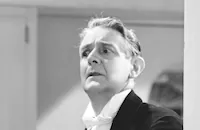The Man Who Broke the Bank at Monte Carlo

Brief Synopsis
Cast & Crew
Stephen Roberts
Ronald Colman
Joan Bennett
Colin Clive
Nigel Bruce
Montagu Love
Film Details
Technical Specs

Synopsis
Paul Gallard enters the grand casino at a sporting club in Monte Carlo with an empty suitcase and proceeds to win ten million francs at the baccarat table before the bank surrenders and closes for the night. Paul fills the suitcase with bank notes and the next day announces he is leaving that evening. Upset that he has been quoted in newspapers stating that his win was a miracle that could never happen again, the management thinks that their business will suffer and try to entice him to stay. He is offered the royal suite and the use of a yacht, and they arrange for him to bump into a hunchback, a sign of luck, and to be given a flower with three four-leaf clovers by a flower girl. Paul tosses the flower away, and it lands inside a horseshoe. When he pays no attention to these lures, the management vows that Paul must return and eat his words. On the train to Paris, Paul overhears a man tell an attractive woman about the beauties of Switzerland, where they plan to go after a connection in Paris. Upon returning to Paris, Paul goes to the kitchen of the Cafe Russe, where he divides his winnings with his fellow Russian refugees who had staked him. Paul is actually a former Russian nobleman reduced to driving a taxi in Paris for the past ten years, and he now vows to kill his gambling habit. He boards a train for Switzerland with his former servant Ivan and arranges for the woman whom he saw on the train to Paris to be mistakenly put into his compartment. He learns that the woman is Helen Berkeley and that the man traveling with her is her brother Bertrand. In Switzerland, Helen refuses Paul's many attempts to send her flowers and an invitation to dance; however, while climbing the Alps, Helen falls to a ledge where Paul has stopped. Soon they are riding together and dancing, and she confides in him that she is to be married in a fortnight to a sixty-two-year-old banker because Bertrand needs five million francs. Paul offers to share his Monte Carlo winnings, but she tearfully refuses and asks that he take her away so that they can spend a week together. Paul then ruefully accepts her request that they go to Monte Carlo. Ivan suspects that Helen has been hired to lure Paul back to the gambling tables, and Paul tells her that he would still love her even if Ivan were right, but that something inside would die. Helen actually had been hired by the casino management but since has decided not to go to Monte Carlo. She now confesses to Paul that she loves him, but refuses his marriage proposal. Helen then tells Bertrand that she is quitting despite his reminder that she was only a back street music hall performer when they were hired and that they will be paid 250,000 francs. When Paul tells Bertrand that he wants to marry Helen, Bertrand, to trick him says that she left already for Monte Carlo. While Paul and Ivan drive there, Bertrand tells Helen that they have left. She then changes her train reservation from Paris to Monte Carlo. Upon her arrival, Helen calls Paul's room to stop him from gambling, but Ivan reveals that Paul has already left for the club. Although Paul loses at first, when he is down to his last note, he begins to win. However, when the bank puts up its last tray of chips, worth six million francs, Paul loses. He laughs it off, but seeing Helen coming out of the director's office, he bitterly congratulates her and walks off. One year later, Paul, once again a taxi driver, drops off a passenger at a nightclub where he sees Helen's picture displayed. He gets dressed in tails and attends, and after Helen's song, dances with her and insults her, but then regrets it. Helen follows him and, finding out that he's a taxi driver, rejoices because she says that if he had lots of money, she could not tell him how sorry she is. She confesses she loves him, and together they attend a dinner and dance at the Cafe Russe in commemoration of Czar Nicholas II's birthday.

Director
Stephen Roberts
Cast

Ronald Colman

Joan Bennett

Colin Clive

Nigel Bruce

Montagu Love

Frank Reicher
Lionel Pape
Ferdinand Gottschalk
Charles Fallon
Charles Coleman
Vladimir Bykoff
Leonid Snegoff
John Picorri
Georgette Rhodes
Alphonse Du Bois
George Davis
Louis Mercier
Andre Cheron
Ramsay Hill
Milton Royce
Harold Minjir
Bruce Wyndham

John Carradine
Rudolf Myzet
Fred Sullivan
Anya Taranda
Francisco Maran
Manuel Paris
Walter Bonn
Eva Dennison
Alphonse Martell
William Stack
John Spacey
Don Brodie
John Miltern

Leonard Carey
Jacques Vanaire
General Theodore Lodi

E. E. Clive
Bob De Coudic
Joseph De Stefani
Gino Corrado
Ferdinand Munier
Maurice Cass

John George
Lynn Bari
Georges Sorel
Frank Dunn
Shirley Aaronson
Frank Thornton
Sam Ash
Will Stanton

Christian Rub
Nicholas Soussanin
Alexander Melesh
Joseph Marievsky
Norman Stengel
Jack Vloskin
V. Sabot
N. Mohoff
A. Trevor Bland
Regina Rambeau
Gaston Glass
George Brangier
Arthur Stuart Hall
Dora Clemant
Cecil Weston
Art Miles
Crew
Joseph Aiken
Oscar Bradley
William Darling
Fred Gilbert
Roger Heman
Nunnally Johnson
Nunnally Johnson
Ernest Palmer
Ad Schaumer
Joseph Schenck
Harold Schuster
Howard Ellis Smith
Gwen Wakeling
Darryl F. Zanuck

Film Details
Technical Specs

Articles
The Man Who Broke the Bank at Monte Carlo
The suave and debonair Ronald Colman plays aristocrat in exile Paul Gaillard, a taxi driver in Paris who gambles with money raised by fellow émigrés in the White Russian community. Colman was under contract to 20th Century Pictures when it merged with Fox Film Corporation and The Man Who Broke the Bank at Monte Carlo was his first film for the newly-branded 20th Century Fox. At a brief 71 minutes, it was also the shortest film he made since arriving in Hollywood over a decade ago.
Colman was one of Hollywood's class acts, handsome and sophisticated, with a regal bearing and an elegant and polished speaking voice. He was equally at home as a romantic lead or a tormented hero but he also had a knack for light comedy, which is exactly what The Man Who Broke the Bank at Monte Carlo called for. Producer Darryl F. Zanuck wanted Sylvia Sidney as his love interest, a mysterious woman with an ulterior motive, but was unable to negotiate a loan-out from Paramount Pictures so he reunited Colman with Joan Bennett, his co-star in his talking picture debut Bulldog Drummond (1929). Colin Clive, who had just co-starred with Colman in Clive of India (1935) but will forever be remembered as the original Dr. Henry Frankenstein, plays Bennett's scheming brother. The great character actor Nigel Bruce, who went on to play Dr. Watson to Basil Rathbone's Sherlock Holmes in over a dozen films, provides dryly sardonic counterpoint as Colman's loyal valet.
According to the trade papers of the day, John Ford was initially set to direct but bowed out due to an injury. Stephen Roberts, a silent movie veteran who directed the notorious The Story of Temple Drake (1933), one of the most daring dramas of the pre-code era, and the romantic comedy Star of Midnight (1935) with William Powell and Ginger Rogers, stepped in. It was one of his last pictures. Roberts died less than a year after the release of Monte Carlo at the age of 41, his promising career cut short by a heart attack.
The original song that gave the film its title is nowhere to be heard in the movie but has its own cinematic history. The characters of Orson Welles's The Magnificent Ambersons (1942) sing it during a car ride in the country and Peter O'Toole practically shouts the lyrics as T.E. Lawrence when he travels through the desert in Lawrence of Arabia (1962). More recently it can be heard in Alien: Covenant (2017) as Michael Fassbender's android character croons the song to himself.
While the film remains a footnote in Colman's career, overshadowed by such beloved classics and popular hits as A Tale of Two Cities (1935), Lost Horizon (1937), and The Prisoner of Zenda (1937), it became the center of a major legal case. 20th Century Fox was sued for copyright infringement by the rights holders of the song and the plaintiff, who brought their suit to the Canadian courts, was awarded over $1 million in damages. Fox appealed and in 1938 it was overturned by the Ontario Court of Appeals, which ruled that Fox's use of the song title as the title for their motion picture did not constitute an infringement of copyright since it did not borrow anything else from the song. It set a legal precedent in Canadian copyright law.
Sources:
The Bennett Playbill, Joan Bennett and Lois Kibbee. Holt, Rinehart and Winston, 1970.
Ronald Colman: A Very Private Person, Juliet Benita Colman. William Morrow, 1975.
The Films of Ronald Colman, Lawrence J. Quirk. Citadel Press, 1977.
The Man Who Broke the Bank at Monte Carlo, Robin Quinn. The History Press, 2016.
Francis, Day & Hunter Ltd v Twentieth Century Fox Corp, The Judicial Committee of the Privy Council Decisions. October 12, 1939.
AFI Catalog of Feature Films
IMDb
By Sean Axmaker

The Man Who Broke the Bank at Monte Carlo
Quotes
Trivia
Notes
The end credits were missing from the print viewed. According to Hollywood Reporter, this was Nunnally Johnson's first film as an associate producer. Darryl Zanuck, Twentieth Century-Fox's production head, was beginning, at this time, to implement a policy to form a group of associate producers from among the writers at the studio. According to news items, John Ford was originally set to direct, but he was forced to relinquish the job because he slipped on his yacht and fractured two vertebrae. According to Hollywood Reporter news items, editor Harold Schuster, who was set to direct Fly by Night, which Zanuck shelved soon after the new company was formed, was to assist on the set of this film. Schuster, who also lost the chance to direct a film for Fox four years earlier when the Chase Manhattan bankers took over the studio, left the company, with which he worked for nine years, after the editing of this film was complete. According to Hollywood Reporter, the studio tried to borrow Sylvia Sidney from Paramount for the lead, but Paramout could not juggle the dates for her other commitments. Belle Daube is listed as a cast member in Hollywood Reporter production charts, but her participation in the final film has not been confirmed. In 1938, a justice for the Ontario Court of Appeals overruled a lower court decision on a case concerning this film and decided that the utilization of a song title as the title for a motion picture does not constitute an infringement of copyright. The lower court decision had awarded the petitioner, Francis, Day and Hunter, who held the copyright to the song, an award of $1,046,350.














